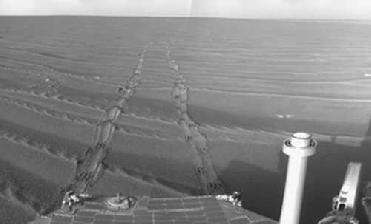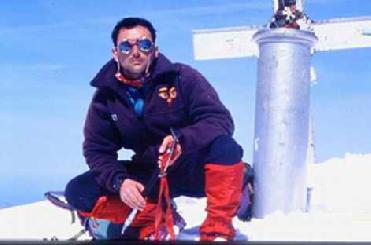
This mosaic of frames from the navigation camera on NASA's Mars Exploration Rover Opportunity gives a view to the northeast from the rover's position on its 1,687th Martian day, or sol (Oct. 22, 2008). By that date, Opportunity had driven southwestward from Victoria Crater, beginning a long trek toward a larger crater, Endeavour. NASA photo
WASHINGTON (BNS): NASA’s mars rovers Spirit and Opportunity will be celebrating the fifth anniversaries of their landing on the Red Planet on January 3.
It was exactly five years ago on January 3, 2004 that Spirit landed on the planet amidst cheers from hundreds of engineers and scientists at NASA's Jet Propulsion Laboratory.
After 21 days, Opportunity too landed on Mars and both of them were given an initial period of three months of stay. Scientists are glad that both the rovers are doing well and will be in full operation even in the coming year.
Ed Weiler, associate administrator for NASA's Science Mission Directorate at NASA Headquarters in Washington, said that the American taxpayer was told three months for each rover was the prime mission plan. "The twins have worked almost 20 times that long. That's an extraordinary return of investment in these challenging budgetary times," Weiler said.
Mission managers at NASA said that the rovers had made important discoveries about wet and violent environments on ancient Mars. They also have returned a quarter-million images, driven more than 13 miles, climbed a mountain, descended into craters, struggled with sand traps and aging hardware, survived dust storms, and relayed more than 36 gigabytes of data via NASA's Mars Odyssey orbiter. To date, the rovers remain operational for new campaigns the team has planned for them, they said.
John Callas, JPL project manager for Spirit and Opportunity said that these rovers are incredibly resilient considering the extreme environment the hardware experiences every day. "We realise that a major rover component on either vehicle could fail at any time and end a mission with no advance notice, but on the other hand, we could accomplish the equivalent duration of four more prime missions on each rover in the year ahead," Callas said. The manager said that this last winter was a squeaker for Spirit, and one just made it through.
NASA said that occasional cleaning of dust from the rovers' solar panels by Martian wind has provided unanticipated aid to the vehicles' longevity. However, it is unreliable aid. Spirit has not had a good cleaning for more than 18 months. Dust-coated solar panels barely provided enough power for Spirit to survive its third southern-hemisphere winter, which ended in December, they said.
According to NASA's plans with Spirit's energy rising for spring and summer, it would drive the rover to a pair of destinations about 200 yards south of the site where Spirit spent most of 2008. One is a mound that might yield support for an interpretation that a plateau Spirit has studied since 2006, called Home Plate, is a remnant of a once more-extensive sheet of explosive volcanic material. The other destination is a house-size pit called Goddard, scientists said.
Steve Squyres of Cornell University, in Ithaca, New York and principal investigator for rover science instruments, said that Goddard doesn't look like an impact crater. "We suspect it might be a volcanic explosion crater, and that's something we haven't seen before," Squyres said.
NASA said that a light-toned ring around the inside of the pit might add information about a nearby patch of bright, silica-rich soil that Squyres counts as Spirit's most important discovery so far. Spirit churned up the silica in mid-2007 with an immobile wheel that the rover has dragged like an anchor since it quit working in 2006. The silica was likely produced in an environment of hot springs or steam vents, NASA said.
For Opportunity, the next major destination is Endeavour Crater. It is approximately 14 miles in diameter, more than 20 times larger than another impact crater, Victoria, where Opportunity spent most of the past two years. Although Endeavour is 7 miles from Victoria, it is considerably farther as the rover drives on a route evading major obstacles.
Since climbing out of Victoria four months ago, Opportunity has driven more than a mile of its route toward Endeavour and stopped to inspect the first of several loose rocks the team plans to examine along the way. High-resolution images from NASA's Mars Reconnaissance Orbiter, which reached Mars in 2006, are helping the team plot routes around potential sand traps that were not previously discernable from orbit, NASA said.
"The journeys have been motivated by science, but have led to something else important. This has turned into humanity's first overland expedition on another planet. When people look back on this period of Mars exploration decades from now, Spirit and Opportunity may be considered most significant not for the science they accomplished, but for the first time we truly went exploring across the surface of Mars," Squyres said.
 Next Article
Next Article













The Indian Air Force, in its flight trials evaluation report submitted before the Defence Ministry l..
view articleAn insight into the Medium Multi-Role Combat Aircraft competition...
view articleSky enthusiasts can now spot the International Space Station (ISS) commanded by Indian-American astr..
view article